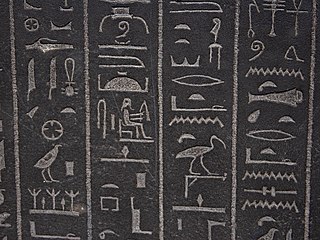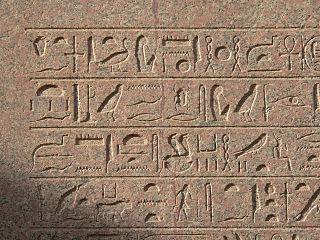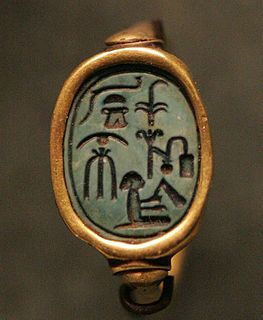
The Egyptian hieroglyph Emblem of the West represents the goddess Imentet, personification of the afterlife. It is composed of a hawk or ostrich feather. The alternate version of the symbol contains the complete figure of the hawk, for Horus, with the feather extending sideways, making it similar to the iat standard, surmounted by individual gods. The feather is associated with the headdress worn by the Libyans.
The Egyptian hieroglyph representing gold, phonetic value nb, is important due to its use in the Horus-of-Gold name, one of the Fivefold Titulary names of the Egyptian pharaoh.
The ancient Egyptian child hieroglyph is part of the Egyptian Gardiner's Sign List hieroglyphs for the beginning core subgroup of Man and his Occupations. It relates to the child, and childhood, and has a version for the Pharaoh, as a child.

The ancient Egyptian Sky hieroglyph,, is Gardiner sign listed no. N1, within the Gardiner signs for sky, earth, and water.

The Ancient Egyptian Townsite-city-region (hieroglyph) is Gardiner sign listed no. O49 for the intersection of a town's streets. In some Egyptian hieroglyphs books it is called a City Plan.

The use of the spine with fluid hieroglyph is for words showing "length", as opposed to 'breadth',. Some example words for 'length' are: to be long, length, to extend, extended; and for to expand, to dilate, words like: joy, gladness, pleasure, delight.
The Ancient Egyptian Swallow hieroglyph is Gardiner sign listed no. G36 for swallow birds. The Sparrow hieroglyph appears similar in size and shape, but it is used to represent small, or bad items.
The grape arbor hieroglyph is used in Egyptian hieroglyphs as a determinative, or ideogram for words related to the "vineyard", i3rrt, or for 'wine', irp; it is also used for describing 'fruit' or 'orchards'.
The ancient Egyptian Face hieroglyph, Gardiner sign listed no. D2 is a portrayal of the human face, frontal view.

The ancient Egyptian Two Whips with Shen ring hieroglyph, Gardiner sign listed no. S23 is a portrayal of the Shen ring with two Egyptian flails-(Crook and flail); it is a member of the Gardiner subset for "crowns, dress, staves, etc".

In the Egyptian language, the single stair hieroglyph is used as a determinative.

The ancient Egyptian Water-jugs-in-stand hieroglyph, is Gardiner sign listed no. W17, W18, within the Gardiner signs for vessels of stone and earthenware.

The ancient Egyptian Scribe equipment hieroglyph 𓏞, or its reversed form 𓏟, portrays the equipment of the scribe. Numerous scribes used the hieroglyph in stating their name, either on papyrus documents, but especially on statuary or tomb reliefs.

The Three-Fox-Skins (hieroglyph) is Gardiner's sign listed no. F31, in the series of parts of animals. It consists of 3-fox skins tied at one end, and hanging, creating flowing skins.

The Egyptian hieroglyph representing a honey bee. It is used as an ideogram for "bee" (bjt), but most frequently as part of the title of the King of Upper and Lower Egypt, rendered nswt-bjtj.

The irrigated land hieroglyph represents "district, nome". It is a determinative in the name of provinces and regions in the noun ḥsp, for "garden", "vegetable garden", and "orchard".

In Egyptian hieroglyphs, the hieroglyph is used for the phonetic value of sma, with meanings of to join together, to unite with.

The Hippopotamus (hieroglyph) is Gardiner sign listed no. E25, in the category of mammals. It is used in Egyptian hieroglyphs as a determinative in words designating the animal, in Egyptian as db, and kh3b.

Some artistic versions of the papyrus roll show the laminations, or grid-work, the cross-hatching of the papyrus fibers, for example on Thutmosis III's cartouches.













